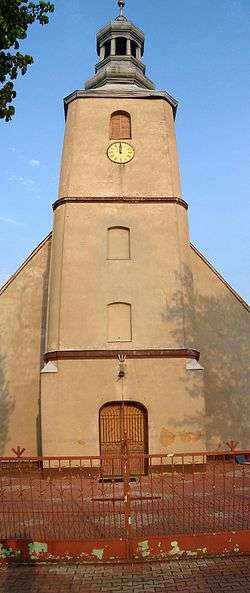Wszechświęte, Lower Silesian Voivodeship
| Wszechświęte | |
|---|---|
| Village | |
 Wszechświęte | |
| Coordinates: 51°11′30″N 17°29′05″E / 51.19167°N 17.48472°E | |
| Country |
|
| Voivodeship | Lower Silesian |
| County | Oleśnica |
| Gmina | Gmina Oleśnica |
| Population | 235 |
Wszechświęte [fʂɛxɕˈfjɛntɛ] (German: Allerheiligen) is a village in the administrative district of Gmina Oleśnica, within Oleśnica County, Lower Silesian Voivodeship, in south-western Poland.[1] Prior to 1945 it was in Germany.
The village lies 8 km(about 5 miles) from Oleśnica
Organizations
In the village there are three organizations
- Folk music band "Wreaths" (from Polish "Wianki")
- Internship Volunteer Fire Service
- Football team

Postcard from Wszechświęte of 1930

The Church in the village Wszechświęte
Area
Village Wszechświęte occupies an area of 398.55 hectares of the agricultural area is 358.48 hectares. In addition to the general area include:
- arable land - 311.91 hectares
- meadows - 31.75 ha
- ha pastures -12.81
- orchards - 2.01 ha
- built-up areas - 10.49 ha
- forests - 7.77 ha
- water - 3.54 ha
- road - 16.59 ha
- Waste land - 1.60 ha
Names
Village over the years has changed names three times:
- 1317 - Omnium Sanctorum (Latin for All Saints)
- 1376 - Alle Heilig (German: All Saints)
- 1785 - Allerheiligen
History
- 1317 - first mention. In a document concerning a dispute about tithes Berold has been replaced - the parish priest in the village Wszechświęte.
- 1376 - city mentioned, as established under German law. The church had a call All Saints (whence the name of the village)
- 1380 - in the village, there was the good knight, which własnośd Pecko Krompusch
- 1597 - Evangelical clergyman has been replaced Bartolomeus Glassius
- 1705 - The old church was completely rebuilt (due to the implementation of the Protestant community)
- 1785 - began operating in the village school, and your farm. Village had 143 inhabitants, three household serfs, 13 zagrodniczych, 3 cottagers
- 1819 - von Hautcharmoi sold the family fortune from Schickfus
- 1845 - owner of the village was the deputy court in nica, Gustav Moritz von Schickfus. In the village there was a good parish, a palace, a windmill, a mill driven by the power of horses. Village had 27 households inhabited by 281 people (3 of Catholics, Jews 7) in the village to work 15 artisans and merchants, and the evangelical school function.
- 1874 - in the village were 24 farms, inhabited by 149 people (9 Catholics).
- 1860 - Construction of the palace, and the establishment of the park
- 1876 - Hermann von mansion ruled Wiessel. Estate comprised 236 hectares of land
- 1891 - The next owner of the property was the philosophy of Dr. Kurt Seidler.
- 1908 - in the village had 30 houses, 189 inhabitants (23 Catholics).
- 1909 - posiadłośd in the hands of Dr. rights and the district deputy, William Krüger. Size property covered 300 hectares of land, including park and garden of 6 hectares, the farm of 4 ha. To the owner, also owned a distillery and sugar factory. Condition of property continued until 1945
- after 1945 - the property was parceled out between the individual handling user
References
This article is issued from
Wikipedia.
The text is licensed under Creative Commons - Attribution - Sharealike.
Additional terms may apply for the media files.